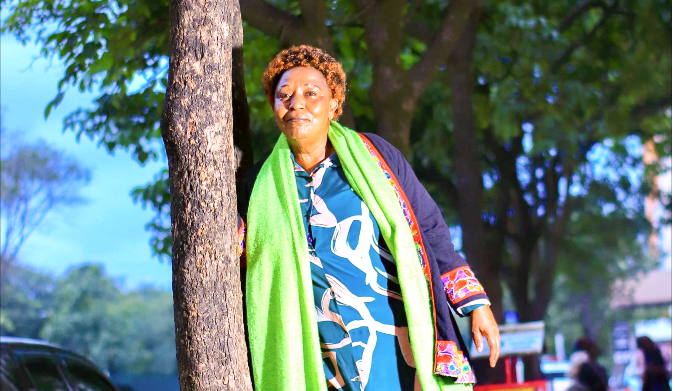

STORY BY SETH ONYANGO,
BIRD STORY AGENCY
Christine Wangari wrapped her arms around the rough trunk of a towering acacia in Michuki Park, Nairobi, her fingers tracing the fissured bark of a tree that, two decades ago, had been a fragile seedling in her nursery in Nakuru, Rift Valley, Kenya.
The park, once a neglected strip of dust and debris, had come alive—crotons blazed with colour, neems stretched skyward, and ficus roots anchored the earth, while the Nairobi River snaked through the revived landscape.
At 2 am in 2006, when most of Nairobi lay silent under amber floodlights, Wangari stood watch. Empty cargo trucks, diverted from Mombasa-bound routes, idled as workers unloaded thousands of tree seedlings—neem, croton, olea, bamboo, ficus, Thika palm, and more.
The trailers, heavy with a payload of tree seedlings, rolled in from Nakuru, where her organisation, Multitouch International (MTI), nurtured over three million saplings.
Multitouch had secured a bid from the city after offering the lowest quote, utilising empty Mombasa-bound trucks to transport more than a million trees from its Nakuru nurseries to the capital.
At the time, Nairobi city authorities were investing heavily in lawn beautification, pouring water by the truckload into landscapes that browned at the first sign of drought. To Wangari, this was wastage and short-term thinking.
“I had watched this cycle go on for years… planting, watering, replacing. Beautiful, yes. But unsustainable,” she recalled.
The problem, she noticed, was not that Nairobi lacked green spaces. It was that the green never stayed. She had an idea. And instead of waiting for a contract or a call, she went to the town hall.
She asked for a meeting with the then-town clerk, the late John Gakuo. When the two finally sat down, she laid out her pitch.
"Grass and flowers needed constant water,” she said. Trees did not.
She thought that instead of Nairobi spending a fortune keeping lawns alive, the city council could supply trees instead. Real trees. Not the tidy little decorative ones, but varieties that could outlive their planters. She had rows of them in Nakuru, ready to load onto the trailers that returned empty to Mombasa after delivering cargo westward.
They could ride for a fraction of the cost since they were returning empty anyway. She just needed the city’s buy-in.
Gakuo listened, asked questions, and then gave her a chance. A tender was floated, and Wangari’s company, Multitouch International, submitted the winning bid.
Soon after, Nairobi began to change, from a concrete jungle to the “green city under the sun,” as it is fondly known today.
Armed with a contract to supply trees to the capital, Wangari was killing two birds with one stone—greening it while saving the trees in her nurseries, which had grown faster than the demand could absorb.
Her advocacy had been inspired by her mentor, the late Wangari Maathai’s clarion call to reforest the country, when national tree cover had plummeted to 1.7%.
“Professor Maathai couldn’t take in our seedlings. She had her own programs. But the city? The city had potential.”
From her base in Nakuru, she coordinated an unlikely green revolution—one that moved on borrowed trailers and bloomed in places few thought possible: roadside shoulders, airport edges, school compounds, riverbanks.
But planting trees in Nairobi was no poetic walk in Karura. It was messy, muddy, political, costly, and often thankless.
“The authorities passed on seedling losses to us, unfairly, even when they failed to water them. But we didn’t stop,” Wangari said.
Christine’s team didn’t do the planting themselves. But they knew the soil. They supervised species choices, ensuring what went into the ground belonged there.
They taught city workers which roots would thrive in shallow urban beds and which would outgrow their welcome. Still, as the city’s appetite for greenery swelled, that caution was overrun by enthusiasm.
“There was a point when the whole thing became hyped. People just wanted big, beautiful trees. Suitability was forgotten. But you couldn’t argue—it had caught on. Nairobians were waking up to trees,” she recalled.
Palm, bombax, and Thika palm trees—species once tucked away in arboretums—were suddenly lining bus stages and river paths. Michuki Park, then a contested, neglected strip, turned into a breathing green corridor.
Wangari's work earned her international acclaim as well when, in 2012, she received the Energy Global Award in Sweden for her conservation efforts to help reclaim water catchments.
She is now among the leading voices driving Kenya's climate agenda in the period following the death of acclaimed Kenyan environmentalist and Nobel prize winner Wangari Maathai. Wangari was one of Maathai's acolytes.
Wangari founded Multitouch in 2003, a climate-conscious non-profit organisation that advocates for pragmatic, ecological conservation.
Since its inception, the tree-planting organisation has been influencing agroforestry practice in the country, focusing on water catchment and reclamation of viable semi-arid and arid lands (ASALs).
The work aims to mitigate deforestation, desertification, and degraded river ecosystems—all key to the mitigation of unemployment, poverty, diseases, urban migration, hunger, and other climate change-related complexities.
Wangari's resolve has helped shape government policies on agroforestry and is credited, together with fellow activists, with pushing Kenya to outlaw single-use plastic bags in 2017.
In the same year, she doubled down, launching her most ambitious initiative yet—the 40 Billion Trees, One Million Jobs initiative—demonstrating how environmental campaigns can create employment for the youth.
Today, Christine drives through Nairobi, proud of what the city has morphed into. She can trace the candlenuts near City Stadium, the ficus along the Mathare River, and the crotons brushing against school fences. Each tree tells a story of negotiation, of hauling, of loss, of resilience.
“Trees are the ultimate basis of both human and wildlife life,” she said. “They give us water, climate stability, even jobs. They’re not decorative but essential for our own survival.”











